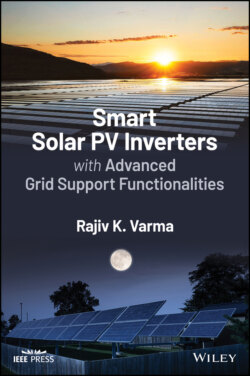Читать книгу Smart Solar PV Inverters with Advanced Grid Support Functionalities - Rajiv K. Varma - Страница 31
1.2.3 Reverse Power Flow
ОглавлениеLarge penetration levels of solar PV may offset the feeder loads and cause excess power to flow in the reverse direction in the grid. This can potentially occur during daytime with solar PV‐based DERs, and typically in the night (during high wind conditions) with wind‐based DERs [27]. Power systems are traditionally designed for unidirectional power flow. However, with the growing installations of DERs, power can flow potentially in a bidirectional manner.
Wind typically blows during nighttime, as in Ontario, Canada. In feeders where wind farms are connected, reverse power flow usually occurs during night since loads are much lower during nighttime as compared to daytime. Such reverse flow of power causes voltages to rise in the feeder that may exceed acceptable limits during the prevalent light‐loading conditions.
A case study is presented for a realistic distribution feeder in Ontario which has a solar PV farm and a wind farm connected on the same feeder [35]. The study system shown in Figure 1.10 consists of a 27.6 kV radial distribution network 45 km long connected to a supply substation through 118/27.6 kV transformer. A solar farm of 8.5 MW is connected 5 km away from a self‐excited induction generator‐based wind farm. The load is considered to be lumped at the feeder end. The daytime peak load is considered to be 4.82 MW and 2.19 Mvar whereas the nighttime load is considered to be 2.1 MW, 0.73 Mvar (1.76 MVA at 0.91 lagging power factor).
Figure 1.10 A realistic distribution feeder in Ontario.
The objective of this study is to determine the maximum amount of wind power that can be connected during daytime and nighttime without violating the utility steady‐state voltage limit of 1.06 pu. The wind farm PCC voltage (obtained through load flow studies) is plotted with increasing amount of wind power for nighttime and three cases for daytime: Case 1 with 0% solar PV power output (0.0 MW), Case 2 with 50% PV output (4.25 MW), and Case 3 with 100% PV output (8.5 MW). Load flow studies are performed for all three cases with increasing wind farm output. The maximum wind power that can be integrated into the grid without violating voltage limits in the grid is 13.1 MW for Case 1, 8.8 MW for Case 2, and 4.36 MW for Case 3. During nighttime, when the load is lowest, the maximum wind power output permissible is only 4.04 MW. This demonstrates that in the night when wind availability is the highest and feeder load is minimum, only a very small amount of wind power can be connected to the grid due to steady‐state voltage rise limitations. Such voltage limit violations have led utilities to restrict the amount of wind power systems to be connected on specific feeders. On another note, it is seen that a high level of wind power generation (within the thermal limit of the feeder) tends to decrease the voltage profile due to reactive power absorption in the feeder and the transformer connecting the wind farm to the feeder (Figure 1.11).
Figure 1.11 PCC bus voltages for various solar farm output cases with increasing wind farm output (daytime and nighttime).
Reduction of active power production is one means to address this steady‐state overvoltage issue [36]. An adaptive voltage control strategy utilizing an LTC and automatic voltage control relay was proposed in [37] to increase the active power output from the DERs while still keeping the voltage regulated within limits. In certain jurisdictions, FACTS Controllers, such as Static VAR Compensators, STATCOMs, or DVARs, have been installed to stabilize the dynamic voltage variations caused by varying wind power generation [38–41].
Protection and relaying systems, voltage regulators, LTCs with line drop compensation, are typically designed for one way flow of power. Reverse power flow, therefore, adversely impacts the operation of such systems. High amount of reverse power flows may cause interruption rating of the circuit protection systems to be exceeded as well as cause sympathetic tripping of adjacent circuits.
Sectionalizers and fault indicators that are commonly used in distribution systems are based on radial flow of power. They can misoperate in scenarios where power flow can change direction. These radial devices need to be replaced or reconfigured, else they may provide erroneous information about fault locations making system restoration difficult [26].
Voltage regulators, even if they are reconfigured for bidirectional power flow, can only control the voltage in close vicinity. They are unable to regulate the voltage between the regulator and the DER when voltage increases occur due to reverse power flow [26]. The customers near the DER may still experience high voltages in cases of large reverse flow due to high penetration of DERs.
To circumvent these issues due to reverse power flow, the protection system settings, voltage regulators, and tap changer operations must be reconfigured to respond correctly during bidirectional power flows. In case of reverse power flow in single‐phase systems, phase balancing must be pursued as a mitigation measure [24].
However, there are many distribution systems having large PV plants where reverse power flow routinely occurs and the protection systems are well‐designed to handle such normal operations.
